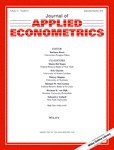
Everaert, G., Pozzi, L. and Schoonackers, R. (2017). On the stability of the excess sensitivity of aggregate consumption growth in the USA Journal of Applied Econometrics, 32(4):819--840.
-
Affiliated author
-
Publication year2017
-
JournalJournal of Applied Econometrics
This paper investigates whether there is time variation in the excess sensitivity of aggregate consumption growth to anticipated aggregate disposable income growth using quarterly US data over the period 1953–2014. Our empirical framework contains the possibility of stickiness in aggregate consumption growth and takes into account measurement error and time aggregation. Our empirical specification is cast into a Bayesian state-space model and estimated using Markov chain Monte Carlo (MCMC) methods. We use a Bayesian model selection approach to deal with the non-regular test for the null hypothesis of no time variation in the excess sensitivity parameter. Anticipated disposable income growth is calculated by incorporating an instrumental variables estimation approach into our MCMC algorithm. Our results suggest that the excess sensitivity parameter in the USA is stable at around 0.23 over the entire sample period. Copyright {\textcopyright} 2016 John Wiley \& Sons, Ltd.